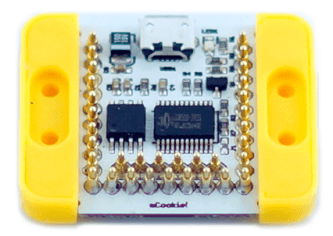Review: mCookie modules make Arduino rhyme with Lego®

To these stackable modules about 15 small cards equipped with microconnectors allow you to connect various sensors, actuators or indicators: RGB LED, switches, various sensors (impact, humidity, temperature etc), PIR detector, IR transmitter and receiver, RGB sensor, buzzer, microphone, joystick, motor, servo (with mounting bracket and screws, if you please!). It also comes with accessories that are just as well made, like the battery holder with switches, USB Cable, a set of 18 mini-cables for the sensors, two mini loudspeakers and also 8 blocks compatible with LEGO® studs.

This list would rightly be incomplete without mentioning the DUO V card which allows you to reduce the vertical size of a stack of modules by juxtaposing the mini IR remote control or the OLED display mini module.
These products are Arduino compatible: depending on your experience in this domain, you can dive straight into programming with the Arduino development environment and send your programs via the USB interface, or you can program by imitation, Scratch fashion, copying and pasting code snippets that you’ve found.
The instruction manual of 64 pages is in color, richly illustrated. If we consider that a picture is worth a thousand words, that’s a lot of explaining, but here and there a bit more reading matter would better guide the novice. The same goes for their online presence, also a bit bumpy. Their Wiki is not perfect (especially if you don’t read Chinese) but it is getting better all the time, as shown by the very comprehensive page on the Bluetooth module.
Conclusion: If you think that the main purpose of mCookie is to reduce costs, then you’ll be frowning. If however you want to offer a user an Arduino compatible tool with a bit of class in its design, which avoids those breadboards and rat’s nests of wires, with a strong teaching potential without getting mired in the technology, then mCookie is very worthy of your consideration. Once a basic familiarity of the main functions is gained, inventive users who don’t have a strong hardware knowledge will be happy with these modules. The slogan of mCookie could well be “Creativity is contagious; pass it on!”
This month's “Test Bench” is dedicated to the memory of Marco Polo (1254-1324), who showed the way from Italy to China.
Read full article
Hide full article


Discussion (0 comments)